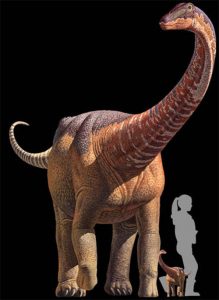
Think your kids grow fast? Scientists say one dinosaur baby went from tiny to a true titan in the blink of a prehistoric eye.
At birth, titanosaur babies weighed about as much as average human babies, 6 to 8 pounds. But in just a few weeks, they were at least the size of golden retrievers, weighing 70 pounds.
And by age 20 or so, they were bigger than school buses.
That jump from something that you could hold in your hands to one of the largest creatures to ever roam Earth beats anything scientists have seen before in terms of growth, said paleontologist Kristi Curry Rogers of Macalester College in St. Paul, Minnesota. She is lead author of a new study on the baby dino fossils published Thursday in the journal Science.
By comparison, modern giants like whales, elephants and hippos are born much bigger than titanosaurs (Tie-TAN-O-SORES). Jeff Wilson of the University of Michigan who wasn’t part of the study said this is the paradox of this class of dinosaurs: They started out as tiny eggs and ended up as the largest animals on the planet.
Titanosaurs, plant-eating dinosaurs which lived about 67 million years ago, grew to be 15 feet tall, not including their necks and heads. They could stretch out to be 50 feet long. Looking through old bones stored in a museum after a dig in Madagascar, Rogers found enough small bone fossils to reconstruct a soon-after-hatching rapetosaurus (Ruh-PAY-too-SORE-us), a type of titanosaur. The baby dinosaur died of starvation during a drought that killed many others in the region, she said.
And yes, you could call it cute.
“There is no doubt that these baby titanosaurs would have had some of the features we would normally associate with cuteness or baby-ness: short snout, large eyes, big head for a body—like a puppy,” said Luis Chiappe, director of the Dinosaur Institute at the Natural History Museum of Los Angeles, who wasn’t part of the research but praised it.
The fossils confirmed that these creatures were precocious, Rogers said: They hatched from the egg pretty much ready to walk and live on their own.
It would have been hard for the giant parents to care for their babies. They had 20 to 30 softball size eggs in a nest and when they hatched, it would have been hard for the adults “to keep track of all the babies around their feet,” Rogers said. “It was just a free-for-all.”
Reference:
“Precociality in a tiny titanosaur from the Cretaceous of Madagascar,” Science, DOI: 10.1126/science.aaf1509
Note: The above post is reprinted from materials provided by The Associated Press.










